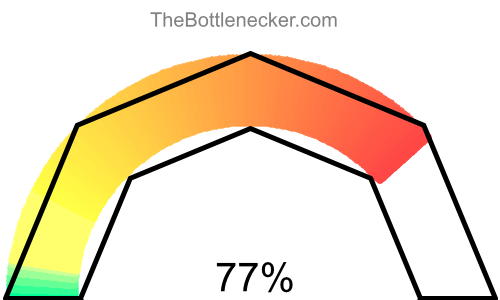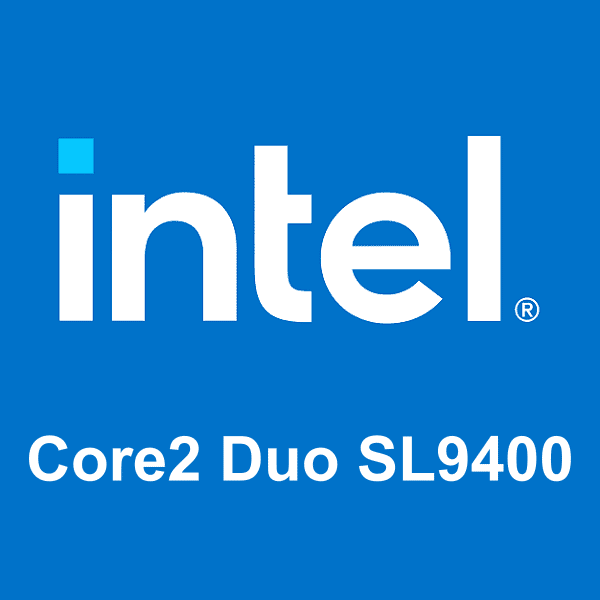Graphic Card Intense Tasks bottleneck calculator
Intel Core2 Duo SL9400 and AMD Radeon RX 6750 XT
Graphic Card Intense Tasks
1024 × 768
1 monitor
1. Select purpose
Currently selected:

Graphic Card Intense Tasks
2. Select processor
Currently selected:
Intel Core2 Duo SL9400
3. Select graphic card
Currently selected:
AMD Radeon RX 6750 XT
4. Select resolution
Currently selected:
1024 × 768 resolution
(1 monitor)
Calculation result
Bottleneck percentage
The Intel Core2 Duo SL9400 may serve as a bottleneck for the AMD Radeon RX 6750 XT in the Graphic Card Intense Tasks with 1024 × 768 and 1 monitor. Although the AMD Radeon RX 6750 XT is engineered to manage heavy graphical tasks, the Intel Core2 Duo SL9400 might lack the processing power needed to fully unlock the AMD Radeon RX 6750 XT capabilities. This imbalance may inhibit the overall efficiency of your system, slowing down processing and possibly compromising graphical fidelity. For a more harmonious hardware setup, upgrading to a high-performing processor that can meet the demands of current software and games is advised.

In a configuration featuring the Intel Core2 Duo SL9400 and AMD Radeon RX 6750 XT, with a screen resolution of 1024 × 768 and 1 monitor, the system experiences a 77.1% bottleneck for Graphic Card Intense Tasks.
Processor and graphic card utilizations
In a computing setup featuring the Intel Core2 Duo SL9400 and AMD Radeon RX 6750 XT, under the context of Graphic Card Intense Tasks with a screen resolution of 1024 × 768 and 1 monitor, the processor is expected to have an utilization rate of 82.5%, while the graphics card is projected to be utilized at 17.2%.
It's crucial to understand that these figures signify theoretical maximums based on typical CPU-to-GPU workload distribution ratios for certain tasks or gaming experiences. Achieving these high levels of utilization in real-world settings can be a challenging endeavor.

Playability
- Playable
- Frames per second
-
A game is considered "playable" if it can consistently run at 60 FPS on high settings. This ensures a smooth and visually appealing gaming experience free from lags or stutters.
Heatmap of bottleneck
In gaming scenarios, your AMD Radeon RX 6750 XT might not attain its full performance potential due to a lack of optimal utilization. This happens when the Intel Core2 Duo SL9400 fails to handle and transmit data to the AMD Radeon RX 6750 XT at an adequate speed. As a result, the Intel Core2 Duo SL9400 will be operating at its maximum capacity, while the AMD Radeon RX 6750 XT remains underutilized.
When it comes to bottlenecks, a processor bottleneck is generally viewed as more detrimental than a graphics card bottleneck. In cases of a processor bottleneck, the Intel Core2 Duo SL9400 capacity reaches its limits, which may adversely affect other applications running concurrently. This situation can result in diminished responsiveness and multi-tasking capabilities.
Moreover, due to the processor bottleneck, the system might not leverage the full performance capabilities of the AMD Radeon RX 6750 XT. Consequently, there could be restrictions in graphical rendering, frame rates, and the overall gaming experience.
To visualize these bottlenecks, consider examining our heatmap. On this heatmap, the X-axis represents the CPU Score, while the Y-axis denotes the GPU Score. A quick glance at this heatmap can offer invaluable insights into potential bottlenecks within various system configurations.

By correlating your Intel Core2 Duo SL9400 CPU Score and AMD Radeon RX 6750 XT GPU Score on the heatmap, you can acquire a more comprehensive understanding of how these components interact and where the bottlenecks might occur. Making well-informed hardware choices based on this heatmap analysis can lead to a more balanced and efficient computing setup for your specific needs.
Bottleneck solutions
Replace processor
When the processor becomes the system's bottleneck, upgrading it is often the most straightforward way to improve performance. Opting for a faster processor with more cores and higher clock speeds can effectively minimize or even eliminate the bottleneck, making it easier for your graphics card to perform to its maximum capability.
- Intel Core i9-13900K Full details
- Intel Core i9-13900KF Full details
- AMD Ryzen Threadripper 3960X Full details
- Intel Core i7-14700K Full details
- AMD Ryzen 9 7900X Full details
- Intel Core i7-14700KF Full details
- AMD Ryzen 9 7900X3D Full details
- Intel Core i9-14900F Full details
- AMD Ryzen Threadripper PRO 7945WX Full details
- AMD Ryzen Threadripper PRO 5955WX Full details
- Intel Core i9-13900F Full details
- Intel Core i7-13700K Full details
- AMD Ryzen 9 7900 Full details
- Intel Core i9-13900 Full details
- Intel Core i9-14900 Full details
- Intel Core i7-13700KF Full details
- AMD Ryzen 9 5950X Full details
- Intel Core i7-14700F Full details
- Intel Core i7-14700 Full details
- Intel Core i9-12900KS Full details
- Intel Core i9-13900T Full details
- Intel Core i5-14600KF Full details
- Intel Core i9-12900K Full details
- Intel Core i9-12900KF Full details
- AMD Ryzen Threadripper PRO 3955WX Full details
- AMD Ryzen Threadripper PRO 5945WX Full details
- AMD EPYC 7642 Full details
- Intel Xeon w7-2495X Full details
- AMD EPYC 7513 Full details
- Intel Xeon w7-2475X Full details
- AMD EPYC 8324P Full details
- AMD EPYC 7443P Full details
- Intel Xeon Gold 5412U Full details
- AMD EPYC 7532 Full details
- AMD EPYC 7502P Full details
- Intel Xeon w5-3435X Full details
- Intel Xeon w5-2465X Full details
- AMD EPYC 7452 Full details
- AMD EPYC 8224P Full details
- AMD EPYC 7542 Full details
- AMD EPYC 7402 Full details
- Intel Xeon Gold 6526Y Full details
- AMD EPYC 73F3 Full details
- AMD EPYC 7313P Full details
- Intel Xeon Gold 6338N Full details
- AMD EPYC 7D12 Full details
- AMD EPYC 9124 Full details
- AMD EPYC 7402P Full details
- Intel Xeon W-3275M Full details
- AMD EPYC 7352 Full details

Impact of Changing Screen Resolution
Interestingly, if you're facing a processor bottleneck, altering the screen resolution may have a counterintuitive impact. Elevating the screen resolution will primarily stress the graphics card, thereby reducing the proportion of work that the processor needs to do in certain tasks. This makes it less likely that the processor will max out, though it does not replace the benefits of a processor upgrade for a balanced system.
Read moreReplace graphic cards
If the processor is causing the bottleneck, replacing the graphic card isn't generally recommended unless you're also planning to upgrade the processor. Downgrading your graphics card to better match the processor might alleviate the bottleneck, but it often results in a decrease in overall system performance, especially in graphics-heavy tasks like gaming or 3D rendering.
- NVIDIA GeForce MX250 Full details
- AMD Radeon Pro WX 3200 Full details
- AMD Radeon R9 M290X Full details
- NVIDIA GeForce MX150 Full details
- NVIDIA GeForce GTX 485M Full details
- NVIDIA GeForce GTX 580M Full details
- NVIDIA GeForce 945M Full details
- NVIDIA Quadro M600M Full details
- NVIDIA Quadro M520 Full details
- NVIDIA GeForce GTX 675M Full details
- NVIDIA GeForce GTX 670MX Full details
- AMD Radeon Pro WX 4130 Full details
- NVIDIA GeForce GTX 765M Full details
- NVIDIA GeForce GTX 760M Full details
- AMD Radeon R9 M375X Full details
- NVIDIA GeForce GTX 670M Full details
- AMD Firepro W5170M Full details
- AMD Radeon Pro WX 2100 Full details
- NVIDIA GeForce MX230 Full details
- NVIDIA GeForce MX130 Full details
- NVIDIA GeForce GTX 570M Full details
- AMD Radeon R9 M275X Full details
- Intel Iris Plus 650 Full details
- NVIDIA GeForce GTX 480M Full details
- AMD Radeon HD 8870M Full details
- NVIDIA GeForce GT 755M Full details
- AMD Radeon HD 6900M Full details
- AMD Radeon Vega 10 Mobile Full details
- AMD Radeon HD 7870M Full details
- NVIDIA GeForce 940MX Full details
- NVIDIA GeForce 845M Full details
- AMD Radeon R9 M370X Full details
- NVIDIA GeForce MX110 Full details
- NVIDIA GeForce GTX 660M Full details
- AMD Radeon R7 M370 Full details
- AMD Radeon Vega 8 Mobile Full details
- Intel Iris Plus 640 Full details
- NVIDIA GeForce GT 750M Full details
- NVIDIA GeForce 930MX Full details
- AMD Radeon R9 M375 Full details
- NVIDIA GeForce 930A Full details
- AMD Radeon HD 8790M Full details
- NVIDIA GeForce GTX 460M Full details
- NVIDIA GeForce GTX 560M Full details
- NVIDIA GeForce GT 745A Full details
- AMD Radeon R9 M270X Full details
- NVIDIA GeForce GT 650M Full details
- AMD FirePro M6000 Mobility Pro Full details
- AMD FirePro M4000 Mobility Pro Full details
- AMD FirePro M40003 Full details

Impact of Changing Screen Resolution
Increasing the screen resolution in this case will demand more from your graphics card and can make the processor's bottleneck less noticeable in some scenarios, but again, it won't entirely solve the underlying problem.
Read moreOffers for AMD Radeon RX 6750 XT
 GAMING TRIO
GAMING TRIO
 Speedster QICK 319 Core
Speedster QICK 319 Core
 MECH 2X OC
MECH 2X OC
 PULSE
PULSE
 AORUS ELITE
AORUS ELITE
 Speedster QICK 319 Core
Speedster QICK 319 Core
Product pricing and availability information was updated as of the date and time listed, but is subject to change. If you choose to purchase a product from a retailer, the price and availability displayed on their website at the time of purchase will apply. We may earn a commission from qualifying purchases made through the links to participating retailers on this site. However, this does not impact the products or prices that are displayed or the order in which prices are listed.
Bottleneck calculator types
Select purpose bottleneck calculator
Before selecting a bottleneck calculator, consider your primary computing tasks. For general activities like web browsing and office work, the calculator evaluates the balance between your CPU and GPU. If you focus on CPU-intensive tasks like video editing or 3D rendering, the tool will highlight processor performance. For GPU-centric tasks such as gaming or graphical rendering, it will assess the efficiency of your graphics card. Choose the appropriate calculator to accurately identify potential system bottlenecks for your specific use-case.
Select game bottleneck calculator
By selecting a game from the list, the calculator will analyze potential bottlenecks specifically tailored to that game's system requirements and graphical demands. This allows you to optimize your setup for a smoother, more responsive gaming experience. Choose the game that aligns with your interests to get the relevant bottleneck analysis.


































